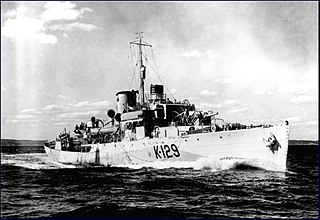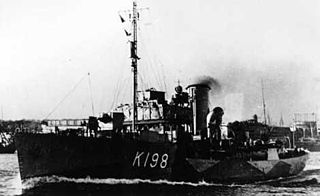
HMCS Rimouski was a Royal Canadian Navy Flower-class corvette which took part in convoy escort duties during the Second World War. She fought primarily in the Battle of the Atlantic. She was named after Rimouski, Quebec.

HMCS Moncton was a Flower-class corvette that served in the Royal Canadian Navy during the Second World War. She served on both coasts of Canada. She is named after Moncton, New Brunswick.

HMCS Mayflower was a Flower-class corvette that served mainly in the Royal Canadian Navy during the Second World War but began her service with the Royal Navy. She saw action primarily in the Battle of the Atlantic as an ocean escort. She was named after the flowering plant Maianthemum canadense.

HMCS Trillium was a Flower-class corvette that served in the Royal Canadian Navy during the Second World War. She served mainly as a convoy escort in the Battle of the Atlantic. She was one of ten corvettes loaned to the Canadian navy by the Royal Navy and the only one which remained an ocean escort throughout the war. She was named after the flowering plant genus Trillium, which includes wakerobin, tri flower, and birthroot.

HMCS Rosthern was a Flower-class corvette that served in the Royal Canadian Navy during the Second World War. She served primarily in the Battle of the Atlantic as a convoy escort. She is named for Rosthern, Saskatchewan.

HMCS Dauphin was a Flower-class corvette that served in the Royal Canadian Navy during the Second World War. She served primarily as a convoy escort in the Battle of the Atlantic. She was named for Dauphin, Manitoba.

HMS Dianthus was a Flower-class corvette of the Royal Navy. She was launched on 9 July 1940 from the Leith Docks on the Firth of Forth and named after the genus of flowering plants including Carnation, Pink, and Sweet William. The ship escorted trade convoys between Newfoundland and the Western Approaches through the Battle of the Atlantic wolf pack attacks of the winter of 1942–43.

HMCS Wetaskiwin was a Flower-class corvette of the Royal Canadian Navy that served during the Second World War. She served primarily as a convoy escort in the Battle of the Atlantic. She was named after the city of Wetaskiwin, Alberta. Wetaskiwin was the first Pacific coast built corvette to enter service with the Royal Canadian Navy.

HMCS Galt was a Flower-class corvette of the Royal Canadian Navy that served during the Second World War. She saw action primarily in the Battle of the Atlantic. She was named after the city of Galt, Ontario.

HMCS Agassiz was a Flower-class corvette of the Royal Canadian Navy. Named after the community of Agassiz, British Columbia, the ship was constructed by Burrard Dry Dock Co. Ltd. in North Vancouver, British Columbia and was launched on 15 August 1940. The corvette was commissioned on 23 January 1941 in Vancouver, British Columbia. The Flower class were initially designed for coastal service during the Second World War, but due to the demands of the Battle of the Atlantic, Agassiz was used primarily as an ocean escort for convoys crossing the Atlantic Ocean in engagements with German submarines. Following the war, the corvette was sold for scrap.

HMCS Eyebright was a Flower-class corvette that served mainly with the Royal Canadian Navy during the Second World War in the Battle of the Atlantic. She was named after the medicinal flowering plant genus Euphrasia.

HMCS Napanee was a Flower-class corvette of the Royal Canadian Navy during the Second World War. She saw service primarily in the Battle of the Atlantic as a convoy escort. She is named after Napanee, Ontario.

HMCS Shediac was a Flower-class corvette of the Royal Canadian Navy during the Second World War. She served primarily in the Battle of the Atlantic as a convoy escort. She was named after the town of Shediac, New Brunswick.

HMCS Chambly was a Flower-class corvette serving in the Royal Canadian Navy. She was ordered from Canadian Vickers Ltd. in Montreal, laid down on 20 February 1940, launched on 29 July, and commissioned on 18 December 1940, named after the city of Chambly, Quebec. Chambly escorted trade convoys between Halifax Harbour and the Western Approaches through the battle of the Atlantic and, together with HMCS Moose Jaw, achieved the RCN's first U-boat kill of the war.

HMCS Spikenard was a Flower-class corvette that served with the Royal Canadian Navy during the Second World War. She served primarily in the Battle of the Atlantic as a convoy escort. She was named for the Spikenard flower.

HMCS Brandon was a Flower-class corvette that served in the Royal Canadian Navy during the Second World War. She saw service primarily in the Battle of the Atlantic as an ocean escort. She was named for Brandon, Manitoba.

HMCS Dunvegan was a Flower-class corvette that served with the Royal Canadian Navy during the Second World War. She served primarily in the Battle of the Atlantic. After the war she was sold to the Venezuelan Navy. She was named for Dunvegan, Inverness County, Nova Scotia.

HMCS Fennel was a Flower-class corvette that served primarily with the Royal Canadian Navy during the Second World War. Originally commissioned into the Royal Navy, she served as an ocean escort in the Battle of the Atlantic.

HMCS Sherbrooke was a Flower-class corvette that served with the Royal Canadian Navy during the Second World War. She served primarily in the Battle of the Atlantic as an ocean escort. She is named for Sherbrooke, Quebec.

HMCS St. Lambert was a modified Flower-class corvette that served with the Royal Canadian Navy during the Second World War. She fought primarily in the Battle of the Atlantic as a convoy escort. She was named for Saint-Lambert, Quebec.





















